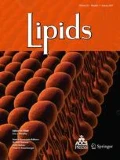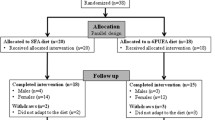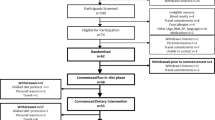Abstract
Normal, healthy male volunteers (n=6) were fed diets [high docosahexaenoic acid-DHA] containing 6 g/d of DHA for 90 d. The stabilization (low-DHA) diet contained less than 50 mg/d of DHA. A control group (n=4) remained on the low-DHA diet for the duration of the study (120 d). Blood samples were drawn on study days 30 (end of the stabilization period), 75 (midpoint of the intervention period), and 120 (end of the intervention period). Adipose tissue (AT) samples were taken on days 30 and 120. The plasma cholesterol (C), low density lipoprotein (LDL)-C and apolipoproteins (apo) [Al, B, and lipoprotein (a)] were unchanged after 90 d, but the triglycerides (TAG) were reduced from a mean value of 76.67±24.32 to 63.83±16.99 mg/dL (n=6, P<0.007 using a paired t-test) and the high density lipoprotein (HDL)-C increased from 34.83±4.38 mg/dL to 37.83±3.32 mg/dL (n=6, P<0.017 using a paired t-test). The control group showed no significant reduction in plasma TAG levels. Apo-E, however, showed a marked increase in the volunteers’ plasma after 90 d on the high-DHA diet, from 7.06±4.47 mg/dL on study day 30 to 12.01±4.96 mg/dL on study day 120 (P<0.002 using a paired t-test). The control subjects showed no significant change in the apo-E in their plasma (8.46±2.90 on day 30 vs. 8.59±2.97 on day 120). The weight percentage of plasma DHA rose from 1.83±0.22 to 8.12±0.76 after 90 d on the high-DHA diet. Although these volunteers were eating a diet free of eicosapentaenoic acid (EPA), plasma EPA levels rose from 0.38±0.05 to 3.39±0.52 (wt%) after consuming the high-DHA diet. The fatty acid composition of plasma lipid fractions—cholesterol esters, TAG, and phospholipid—showed marked similarity in the enrichment of DHA, about 10%, after the subjects consumed the high-DHA diet. The DHA content of these plasma lipid fractions varied from less than 1% (TAG) to 3.5% (phospholipids) at baseline, study day 30. EPA also increased in all plasma lipid fractions after the subjects consumed the high-DHA diet. There were no changes in the plasma DHA or EPA levels in the control group. Consumption of DHA also caused an increase in AT levels of DHA, from 0.10±0.02 to 0.31±0.07 (wt%) (n=6, P<0.001 using a paired t-test), but the amount of EPA in their AT did not change. Thus, dietary DHA will lower plasma TAG without EPA, and DHA is retroconverted to EPA in significant amounts. Dietary DHA appears to enhance apo-E synthesis in the liver. It appears that DHA can be a safe and perhaps beneficial supplement to human diets.
Similar content being viewed by others
Abbreviations
- AA:
-
Arachidonic acid; apo, apolipoprotein
- AT:
-
adipose tissue
- C:
-
cholesterol
- DHA:
-
docosahexaenoic acid
- DPA:
-
docosapentaenoic
- EPA:
-
eicosapentaenoic acid
- FA:
-
fatty acid
- FFA:
-
free fatty acids
- HDL:
-
high density lipoprotein
- LDL:
-
low density lipoprotein
- Lp:
-
lipoprotein
- MRU:
-
metabolic research unit
- RBC:
-
red blood cells
- TAG:
-
triglycerides
References
Bang, H.O., and Dyerberg, J. (1972) Plasma Lipids and Lipoproteins in Greenlandic West Coast Eskimos, Acta Med. Scand. 192, 85–94.
Leaf, A., and Weber, P.C. (1988) Cardiovascular Effects of n-3 Fatty Acids, New Engl. J. Med. 318, 549–557.
Leaf, A. (1990) Cardiovascular Effects of Fish Oil, Circulation 82, 624–628.
Nettleton, J.A. (1995) Omega-3 Fatty Acids and Health, Chapman and Hall, New York, pp. 187–354.
Harris, W.S., Connor, W.E., and McMurry, M.P. (1983) The Comparative Reduction of Plasma Lipids and Lipoproteins by Dietary Polyunsaturated Fats, Salmon Oil Versus Vegetable Oils, Metabolism 32, 179–184.
Harris, W.S., Connor, W.E., Alam, N., and Illingworth, D.R. (1988) Reduction of Postprandial Hypertriglyceridemia in Humans by Dietary n-3 Fatty Acids, J. Lipid Res. 29, 1451–1460.
Harris, W.C., Rothrock, D.W., Fanning, A., Inkeles, S.B., Goodnight, S.H., Illingworth, D.R., and Connor, W.E. (1990) Fish Oils in Hypertriglyceridemia, A Dose Response Study, Am. J. Clin. Nutr. 51, 399–406.
Singer, P., Wirth, M., Voigt, S., Richter-Heinrich, E., Godicke, W., Berger, I., Naumann, E., Listing, J., Hartrodt, W., and Taube, C. (1985) Blood Pressure- and Lipid-Lowering Effects of Mackerel and Herring Diets in Patients with Mild Essential Hypertension, Atheroscl. 56, 223–235.
Sinclair, A.J., O’Dea, K., Smith, I., and Parkin, D. (1986) The Effect of Low-fat Diets Rich in Australian Fish on the Levels of Docosahexaenoic, Eicosapentaenoic and Docosahexaenoic Acids in Plasma Lipids, Prog. Lipid Res. 25, 83–85.
Van Houwelingen, A.C., Hornstra, G., Kromhout, D., and de Lezenne Coulander, C. (1989) Habitual Fish Consumption, Fatty Acids of Serum Phospholipids and Platelet Function, Atherosclerosis 75, 157–165.
Nelson, G.J., Schmidt, P.C., and Corash, L. (1991) Effect of at Salmon Diet on Platelet Aggregation and the Fatty Acid Composition of Platelets, Plasma and Erythrocytes in Normal Adult Men, Lipids, 26, 87–96.
Saynor, R., Verel, D., and Gillott, T. (1984) The Long-term Effect of Dietary Supplementation with Fish Lipid Concentrate on Serum Lipids, Bleeding Time, Platelets and Angina, Atherosclerosis 50, 3–10.
Sanders, T.A.B., and Younger, K.M. (1981) The Effect of Dietary Supplements of ω3 Polyunsaturated Fatty Acids on the Fatty Acid Composition of Platelets and Plasma Choline Phosphoglycerides, Br. J. Med. 225 (Suppl. 1), 99–104.
Sanders, T.A.B., and Hinds, A. (1992) The Influence of Fish Oil High in Docosahexaenoic Acid on Plasma Lipoprotein and Vitamin E Concentrations and Hemostatic Function in Healthy Male Volunteers, Br. J. Nutr. 68, 163–173.
Knapp, H.R., Reilly, A.G., Allesandrini, P., and Fitzgerald, G.A. (1995) In vivo Indexes of Platelet and Vascular Function During Fish Oil Administration in Patients with Atherosclerosis, New Engl. J. Med. 314, 937–942.
Toft, I., Bonaa, K.H., Ingebretsen, O.C., Nordoy, A., and Jenssen, T. (1997) Fibrinolytic Function After Dietary Supplementation with ω3 Fatty Acids, Arterioscl. Thromb. Vascular Biol. 17, 814–819.
Thorngren, M., and Gustafson, A. (1981) Effect of 11-Week Increase in Dietary Eicosapentaenoic Acid on Bleeding Time, Lipids and Platelet Aggregation, Lancet ii, 1190–1193.
Saynor, R., and Verel, D. (1982) Eicosapentaenoic Acid, Bleeding Time, and Serum Lipids, Lancet ii, 272.
Von Schacky, C., and Weber, P.C. (1985) Metabolism and Effects on Platelet Function of the Purified Eicosapentaenoic and Docosahexaenoic Acids in Humans, J. Clin. Invest. 76, 2446–2450.
Conquer, J.A., and Holub, B.J. (1997) Dietary Docosahexaenoic Acid as a Source of Eicosapentaenoic Acid in Vegetarians and Omnivores, Lipids 32, 314–345.
Jonnalagadda, S.S., Egan, S.K., Heimbach, J.T., Harris, S.S., and Kris-Etherton, P.M. (1995) Fatty Acid Consumption Patterns of Americans, 1987–1988, The USDA Nationwide Food Consumption Survey, Nutr. Res. 15, 1767–1781.
Rouser, G., Nelson, G.J., Fleischer, S., and Simon, G. (1968) Analysis and Constitution of Biological Membranes, in Biological Membranes (Chapman, D., ed.) pp. 5–69, Academic Press, New York.
Neuringer, M., Connor, W.E., van Patten, C., and Barstadt, L. (1984) Dietary Omega-3 Deficiency and Visual Loss in Infant Rhesus Monkeys, J. Clin. Invest. 73, 272–279.
Sprecher, H. (1996) New Advances in Fatty Acid Biosynthesis, Nutr. 12 (Suppl. 1), S5–7.
Farquharson, J., Cockburn, F., Patrick, W.A., Jamieson, E.C., and Logon, R.W. (1993) Infant Cerebral Cortex Phospholipid Fatty Acid Composition and Diet, Lancet 340, 810–813.
Brossard, N., Corset, M., Pachiaudi, C., Riou, J.P., Tayot, J.L., and Lagarde, M. (1996) Retroconversion of [13C]22:6n-3 in Humans and Rats After a Single Dose of [13C]22:6n-3-triacylgylcerols, Am. J. Clin. Nutr. 64, 577–586.
Ferrier, L.K., Caston, L.J., Leeson, S., Squires, J., Weaver, B.J., and Holub, B.J. (1995) α-Linolenic Acid- and Docosahexaenoic Acid-Enriched Eggs from Hens Fed Flaxseed, Influence on Blood Lipids and Platelet Phospholipid Fatty Acids in Humans, Am. J. Clin. Nutr. 62, 81–86.
Nelson, G.J., Schmidt, P.C., Bartolini, B., Kelley, D.S., and Kyle, D. (1997) The Effect of Dietary Docosahexaenoic Acid on Platelet Function, Platelet Fatty Acid Composition and Blood Coagulation in Humans, Lipids 32, 1129–1136.
Consumer and Food Economic Institute (1992), The Composition of Foods, in USDA Handbook 8, U.S. Department of Agriculture, Washington, D.C.
National Research Council (1989) Recommended Dietary Allowances, 10th edn., National Academy Press, Washington, D.C.
Phinney, S.D., Tang, A.B., Johnson, S.B., and Holman, R.T. (1990) Reduced Adipose 18:3ω3 with Weight Loss by Very Low Calorie Dieting, Lipids 25, 798–806.
Nelson, G.J. (1972) Handling, Extraction and Storage of Blood Samples, in Blood Lipids and Lipoproteins (Nelson, G.J., ed.), pp. 3–24, Wiley-Interscience, New York.
Nelson, G.J. (1975) Quantitative Analytical Methods for Blood Lipids, in Analysis of Lipids and Lipoproteins (Perkins, E.G., ed.) pp. 1–22, American Oil Chemists’ Society, Champaign.
Nelson, G.J., Kelley, D.S., and Hunt, J.E. (1986) Effect of Nutritional Status on the Fatty Acid Composition of Rat Liver and Cultured Hepatocytes, Lipids 21, 454–459.
Nelson, G.J., Kelley, D.S., Schmidt, P.C., and Serrato, C.M. (1987) The Effect of Fat-Free, Saturated and Polyunsaturated Fat Diets on Rat Liver and Plasma, Lipids 22, 88–94.
Austin, G.E., and Maznicki, E. (1983) Automated Turbidimetric Assay of Apolipoprotein A Using the Cobas-Bio Centrifugal Analyzer, Clin. Biochem. 16, 338–340.
Rifai, N., and King, M.E. (1986) Immunoturbidimetric Assays of Apolipoproteins A, A-I, A-II and B in Serum, Clin. Chem. 32, 957–961.
Silberman, S.R., Jeffries, E., Taddei-Peters, W.C., and Butman, B.T. (1994) Apolipoprotein E ELISA with Similar Reactivity to Free and Lipid-Bound Apo E, and to ApoE*2, ApoE*3 and ApoE*4 in Serum, Clin. Chem. 40, 340.
Butman, B.T., Jones, G., Taddei-Peters, W.C., Venetta, T., and Ransom, J.H. (1991) Development of a Monoclonal Antibody-Based ELIZA for Quantitation of Lp(a) in Plasma, Clin. Chem. 37, 918.
McGowan, M.W., Artiss, J.D., Strandberg, D.R., and Zak, B. (1983) A Peroxide-Coupled Method for the Colorimetric Determination of Serum Triglycerides, Clin. Chem. 29, 538–548.
Allain, C.A., Poon, L.S., Chan, C.G.S., Richmond, W., and Fu, P.C. (1974) Enzymatic Determination of Total Serum Cholesterol, Clin. Chem. 20, 470–479.
Mensink, R.P., and Katan, M.B. (1987) Effect of Monounsaturated Fatty Acids Versus Complex Carbohydrates on High-Density Lipoproteins in Healthy Men and Women, Lancet i, 122–125.
Mensink, R.P., and Katan, M.B. (1989) Effect of a Diet Enriched with Monounsaturated or Polyunsaturated Fatty Acids on Levels of Low-Density and High-Density Lipoprotein Cholesterol Levels in Healthy Women and Men, New Engl. J. Med. 321, 436–441.
Khosla, P., and Hayes, K.C. (1992) Comparison Between the Effects of Dietary Saturated (16∶0), Monounsaturated (18∶0) and Polyunsaturated (18∶2) Fatty Acids on Plasma Lipoprotein Metabolism in Cebus and Rhesus Monkeys Fed Cholesterol-Free Diets, Am. J. Clin. Nutr. 55, 51–62.
Hayes, K.C., and Khosla, P. (1992). Dietary Fatty Acid Thresholds, and Cholesterolemia, FASEB J. 6, 2600–2607.
Ventura, M.A., Woollett, L.A., and Spady, D.K. (1989) Dietary Fish Oil Stimulates Hepatic Low Density Lipoprotein Transport in the Rat, J. Clin. Invest. 84, 528–537.
Wong, S.H., and Nestel, P.J. (1987) Eicosapentaenoic Acid Inhibits the Secretion of Triacylglycerol and of Apoprotein B and the Binding of LDL in Hep G2 Cells, Atherosclerosis 64, 139–146.
Wang, H., Chen, X., and Fisher, E.A. (1993) n-3 Fatty Acids Stimulate Intracellular Degradation of Apoprotein B in Rat Hepatocytes, J. Clin. Invest. 91, 1380–1389.
Failor, R.A., Childs, M.T., and Bierman, E.L. (1988) The Effect of ω3 Fatty Acid-Enriched Diets on Plasma Lipoproteins and Apoproteins in Familial Combined Hyperlipidemia, Metabolism 37, 1021–1028.
Schmidt, E.B., Klausen, I.C., Kristensen, S.D., Lervang, H.-H., Faergeman, O., and Dyerberg, J. (1991) The Effect of n-3 Polyunsaturated Fatty Acids on Lp(a), Clin. Chem. Acta 198, 271–278.
Beil, F.U., Terres, W., Orgass, M., and Greten, H. (1991) Dietary Fish Oil Lowers Lipoprotein(a) in Primary Hypertriglyceridemia, Atherosclerosis 90, 95–97.
Kelley, D.S., Nelson, G.J., Love, J.E., Branch, L.B., Taylor, P.C., Rivera, Y.M., Schmidt, P.C., Mackay, B.E., and Iacono, J.I. (1993) Dietary α-Linolenic Acid Alters Tissue Fatty Acid Composition, But Not Blood Lipids, Lipoproteins or Coagulation Status in Humans, Lipids 28, 533–537.
Shepherd, J., Packard, C.J., Grundy, S.M., Yeshurun, D., Gotto, A.M., Jr., and Taunton, O.D. (1980) Effects of Saturated and Polyunsaturated Fat Diets on the Chemical Composition and Metabolism of Low Density Lipoproteins in Man, J. Lipid Res. 21, 91–99.
Dougherty, R.M., Allman, M.A., and Iacono, J.M. (1995) Effect of Diets Containing High or Low Amounts of Stearic Acid on Plasma Lipoprotein Fractions and Fecal Fatty Acid Excretion of Men, Am. J. Clin. Nutr. 61, 1120–1128.
Nelson, G.J., Schmidt, P.S., Bartolini, G., Kelley, D.S., Phinney, S.D., Kyle, D., Silbermann, S., and Schafer, E. (1997) The Effect of Dietary Arachidonic Acid on Lipoprotein Distributions, Apoproteins, Blood Lipids, and Fatty Acid Composition in Humans, Lipids 32, 427–433.
Marckmann, P., Lassen, A., Haraldsdottir, J., and Sandstrom, B. (1995) Biomarkers of Habitual Fish Intake in Adipose Tissue, Am. J. Clin. Nutr. 62, 956–959.
Phinney, S.D., Odin, R.S., Johnson, S.B., and Holman, R.T. (1990) Reduced Arachidonate in Serum Phospholipids and Cholesterol Esters Associated with Vegetarian Diets in Humans, Am. J. Clin. Nutr. 51, 385–392.
Vidgren, H.M., Agren, J.J., Schwab, U., Rissanen, T., Hanninen, O., and Uusitupa, M.I.J. (1997) Incorporation of n-3 Fatty Acids into Plasma Lipid Fractions, and Erythrocyte Membranes and Platelets During Dietary Supplementation with Fish, Fish Oil and Docosahexenoic Acid-Rich Oil Among Healthy Young Men, Lipids 32, 697–705.
Author information
Authors and Affiliations
About this article
Cite this article
Nelson, G.J., Schmidt, P.C., Bartolini, G.L. et al. The effect of dietary docosahexaenoic acid on plasma lipoproteins and tissue fatty acid composition in humans. Lipids 32, 1137–1146 (1997). https://doi.org/10.1007/s11745-997-0146-5
Received:
Revised:
Accepted:
Issue Date:
DOI: https://doi.org/10.1007/s11745-997-0146-5




